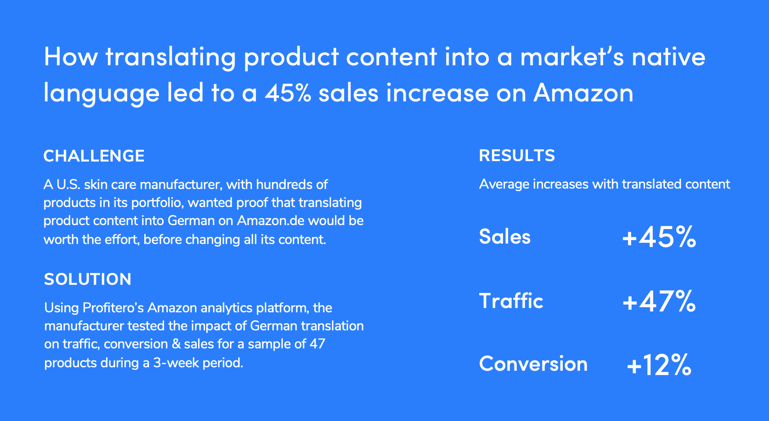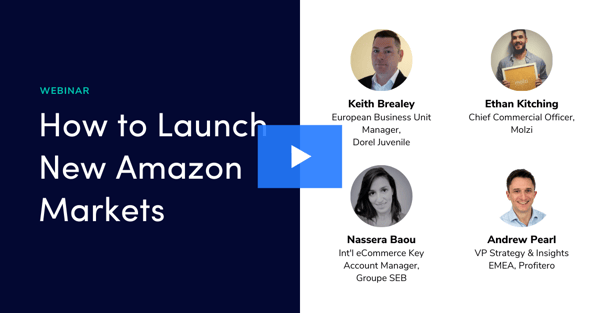

Amazon’s European and Asian expansion creates new growth opportunities for many brands. Operating in these markets can be complex, however.
Here we summarise 5 key learnings from our recent webinar with Dorel, Groupe SEB and Molzi. You can also watch on-demand by clicking below.
1. Approach each Amazon market differently and do your homework
- What Amazon is doing in the U.S. is a good temperature gauge to understand what's potentially coming out next in other markets. It’s a much better indication than what's necessarily coming in Poland, Sweden or the Netherlands, which are all fairly limited in terms of what Amazon products are available.
- Entering new markets requires an understanding of the restrictions within those territories. It’s also important to ensure your company has the right infrastructure and capabilities in place before launching.
- A big challenge with new market entry is developing accurate forecasts. Be careful not to overestimate the market opportunity. Just because the size of a new market is big, Amazon may be relatively small within that territory. And the competitive landscape is very different from market to market. Some Amazon markets may have very strong local competitors, for example Bol.com in the Netherlands; whereas a market like Turkey has fewer local players.
- Fair warning: if you’re going into a market where big brands with big budgets are already established, you may not be able to go head to head with them on things such as keyword bidding. So carefully consider if Amazon is right for you in those markets.
I think it's fair to say that it's quite inconsistent in terms of how Amazon launches new markets.
— Ethan Kirching, COO, Molzi
2. Treat Amazon as one customer: Ensure you don’t have conflicting KPIs by market
- It’s important not to have conflicting KPIs across different Amazon markets. View Amazon as one customer, which is how they see themselves; and have one strategy.
- With Amazon, you can have the same terms in all countries. So push for the same trade agreement in each market (otherwise, you may have conflicts with other countries), and the same pricing too, where possible.
- Transitioning from a traditional retailer model to the demands of Amazon is difficult, so be sure the whole business is on the same page. It’s good to have the proper foundations built internally, which everyone is aligned against. This is especially critical the more you expand.
Once you start to launch new markets, you will learn where the pitfalls are. It's knowing where to hit the brakes, where to have that level of control, and when to say 'we're going to do this at our own pace and in our own time.'
— Keith Brealey, European Business Unit Manager, Dorel Juvenile
3. Get the basics right: Test and learn with a few products first before going all-in
- It’s important to get the basics, like product content, right first in order to get the Amazon flywheel working. It takes time, but it works.
- Localised content is key as advertising doesn’t play a part in all markets (it’s not available in some newer markets). Therefore, ensure your content is retail-ready before you add other growth levers. Translate your product content into the native language if you can, as one of Profitero’s clients did with outstanding results (see the case study below). But, it may not be as simple as translation; you’ll likely want to conduct keyword analysis to truly understand local market nuances.

- You may be tempted to launch all of your products at once, but if that goes wrong (and it can very quickly), it will take a huge amount of resources to pull back in, and get to where you need to be. It’s always a good idea to test and learn with a few products first.
- You may need to over-invest in terms of advertising (where available) to build up your product relevance within a given territory.
Taking advantage of the experience we have in more mature countries has helped us accelerate the launch process in new Amazon markets.
— Nassera Baou, International eCommerce Key Account Manager, Groupe SEB
4. A Pan-European agreement with Amazon is key to creating long-term efficiencies
- Resources you typically have in a mature market aren't necessarily available in newer Amazon markets. For example, in newer markets, a vendor manager is likely looking after three or four categories instead of a single one; so, understand that they are spread pretty thin.
- When you reach a certain size and scale with Amazon, you will benefit from having a relationship that you can then leverage in its smaller countries.
- You can also lean heavily on the Amazon Flex network (Amazon’s own delivery network) if you're based in one country, and want to launch in three or four markets.
5. Consider operating a hybrid 1P/3P model
- Of course you can succeed on Amazon with a first-party (1P) vendor model. But operating as a third-party (3P) seller comes in handy in some instances: for example, when you have a product you want to manage directly; or where you’re losing the Buy Box on 1P and Amazon doesn’t have stock, you can fulfill an order quickly with 3P.
- However, it’s important to understand Amazon’s parameters before entering into a hybrid model. Depending on the strength of your brands in local markets, it’s not likely you’ll be able to invest at the same levels, so a 1P / 3P hybrid model may play a greater or lesser role depending on the market.
If you're just starting up it's healthy to have both 1P and 3P; it can cover you from being crapped out.
— Keith Brealey, European Business Unit Manager, Dorel Juvenile
Contact Profitero to demo our Amazon analytics and learn how we can help you to expand into additional markets.



























